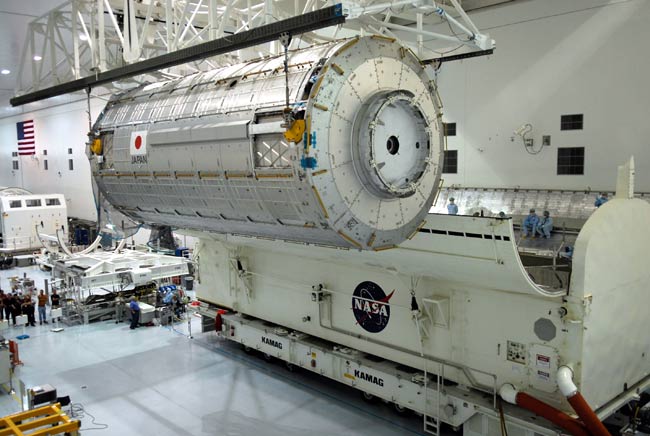Japan's Space Station Laboratory Ready to Fly

HOUSTON — The International Space Station (ISS) is about to get bigger.
Seven astronauts are gearing up to launch aboard NASA's space shuttle Discovery to deliver the station's largest room: the Japanese Kibo laboratory. The 13-day mission is set to rocket spaceward with the tour bus-sized lab from NASA's Kennedy Space Center in Cape Canaveral, Fla., on May 31.
Discovery's mission was pushed back several days due to delays modifying its external fuel tank with post-Columbia accident improvements. The following shuttle flight — NASA's planned Aug. 28 mission aboard Atlantis to overhaul the Hubble Space Telescope - has also been delayed up to five weeks due to similar fuel tank challenges, said space shuttle program manager John Shannon. It will likely launch sometime in late September 2008, he said.
"We've got an exciting mission ahead of us," Discovery commander Mark Kelly said in a Thursday briefing here at NASA's Johnson Space Center. "I think we're fortunate — to be part of the space shuttle program, but to carry one of the major elements to the space station, install it and check it out, is really a great privilege for all of us."
Discovery's STS-124 crew includes Japan Aerospace Exploration Agency rookie astronaut Akihiko Hoshide, eager to help his country realize its space dreams.
"This is a big milestone for the Japanese community," Hoshide said. "A lot of people have worked on this for 20-plus years. This is really a mission to make a dream come true."
Other crew members will include pilot Ken Ham and mission specialists Karen Nyberg, Ron Garan, Mike Fossum and Greg Chamitoff. Chamitoff, a first-time spaceflyer, will relieve American astronaut Garrett Reisman as a flight engineer for the space station's Expedition 17 crew. He'll return on a shuttle flight later this fall.
Breaking space news, the latest updates on rocket launches, skywatching events and more!
The STS-124 mission will mark NASA's third shuttle trip of the year and the second to carry elements of Kibo, which means "hope" in Japanese, to the station. Astronauts delivered a storage module for the new lab during a previous March shuttle mission. Europe's Columbus laboratory was installed on a February spaceflight.
"From our perspective this is one of the most exciting modules for us to be flying," said NASA's station program manager Mike Suffredini. "This module is larger than any that are on the station or that are planned. This is a very exciting time for the program."
While visiting the space station, the astronauts plan to perform three spacewalks to install the new lab and activate its robotic arm, the Japanese Remote Manipulator System. They will also relocate Kibo's smaller attic-like module from its temporary perch, attaching it to the new 37-foot (11.3 meter) main cabin.
The shuttle Discovery is slated to roll out to Launch Pad 39A early Saturday, with the STS-124 crew set to rehearse launch day activities aboard the orbiter late next week.

Clara Moskowitz is a science and space writer who joined the Space.com team in 2008 and served as Assistant Managing Editor from 2011 to 2013. Clara has a bachelor's degree in astronomy and physics from Wesleyan University, and a graduate certificate in science writing from the University of California, Santa Cruz. She covers everything from astronomy to human spaceflight and once aced a NASTAR suborbital spaceflight training program for space missions. Clara is currently Associate Editor of Scientific American. To see her latest project is, follow Clara on Twitter.
